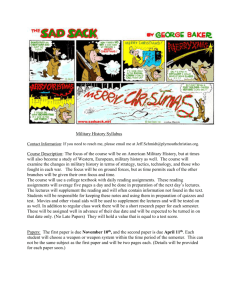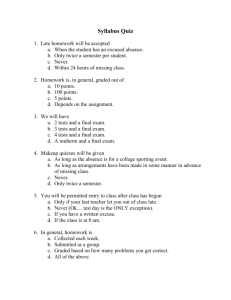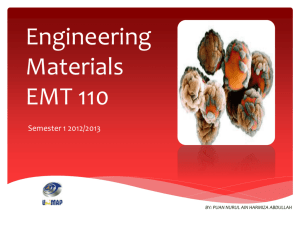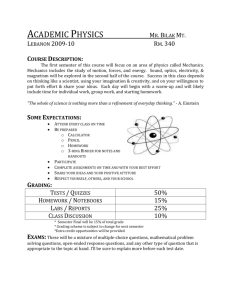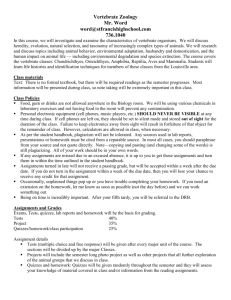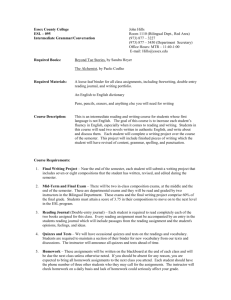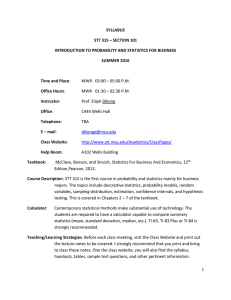EASTERN MEDITERRANEAN UNIVERSITY
advertisement
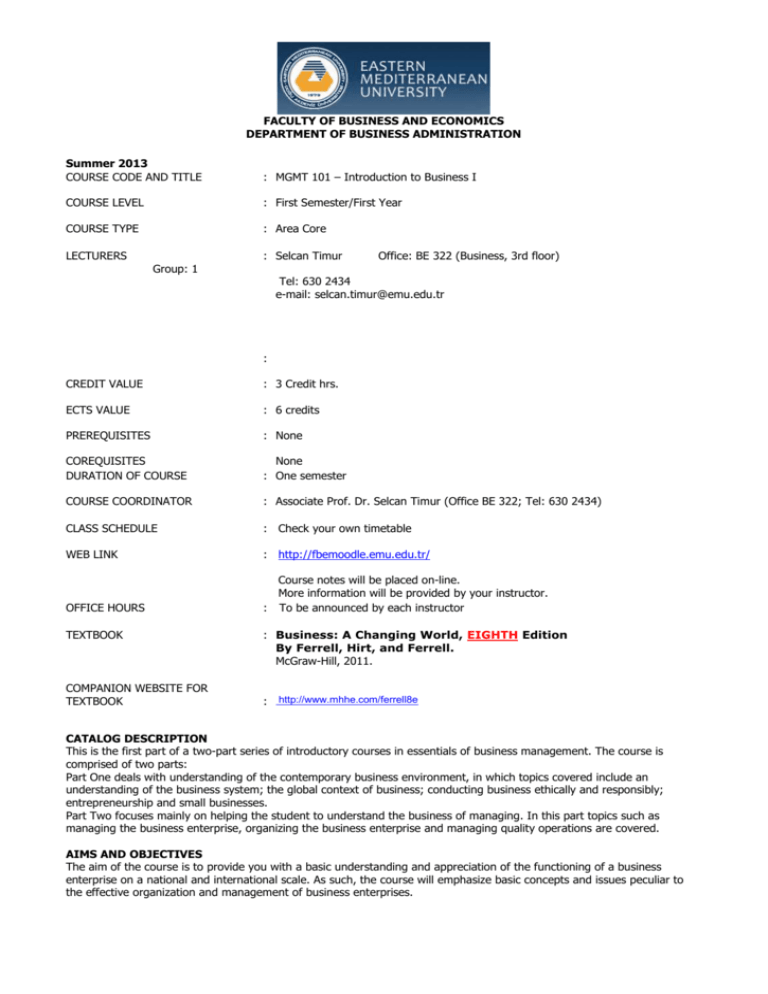
FACULTY OF BUSINESS AND ECONOMICS DEPARTMENT OF BUSINESS ADMINISTRATION Summer 2013 COURSE CODE AND TITLE : MGMT 101 – Introduction to Business I COURSE LEVEL : First Semester/First Year COURSE TYPE : Area Core LECTURERS : Selcan Timur Group: 1 Office: BE 322 (Business, 3rd floor) Tel: 630 2434 e-mail: selcan.timur@emu.edu.tr : CREDIT VALUE : 3 Credit hrs. ECTS VALUE : 6 credits PREREQUISITES : None COREQUISITES DURATION OF COURSE None : One semester COURSE COORDINATOR : Associate Prof. Dr. Selcan Timur (Office BE 322; Tel: 630 2434) CLASS SCHEDULE : Check your own timetable WEB LINK : http://fbemoodle.emu.edu.tr/ OFFICE HOURS Course notes will be placed on-line. More information will be provided by your instructor. : To be announced by each instructor TEXTBOOK COMPANION WEBSITE FOR TEXTBOOK : Business: A Changing World, EIGHTH Edition By Ferrell, Hirt, and Ferrell. McGraw-Hill, 2011. : http://www.mhhe.com/ferrell8e CATALOG DESCRIPTION This is the first part of a two-part series of introductory courses in essentials of business management. The course is comprised of two parts: Part One deals with understanding of the contemporary business environment, in which topics covered include an understanding of the business system; the global context of business; conducting business ethically and responsibly; entrepreneurship and small businesses. Part Two focuses mainly on helping the student to understand the business of managing. In this part topics such as managing the business enterprise, organizing the business enterprise and managing quality operations are covered. AIMS AND OBJECTIVES The aim of the course is to provide you with a basic understanding and appreciation of the functioning of a business enterprise on a national and international scale. As such, the course will emphasize basic concepts and issues peculiar to the effective organization and management of business enterprises. GENERAL LEARNING OUTCOMES On successful completion of this course, all students will have developed knowledge and understanding of: the nature of business and its environment the global nature and context of business organizing and managing a business On successful completion of this course, all students will have developed their skills in: appreciation of the significance of businesses in the production of goods and services appreciation of the importance of business management in the welfare of economies and the people extracting relevant and useful information from reading material, both printed and digital On successful completion of this course, all students will have developed their appreciation of and respect for values and attitudes regarding the issues of: entrepreneurship globalization ethics and responsibility in business successful organization and management of organizations RELATIONSHIP WITH OTHER COURSES This is the first part of a two-part series of introductory courses in essentials of business management. Students who sucessfuly complete this course will take MGMT 102 – Introduction to Business II. LEARNING/TEACHING METHOD Lectures, class discussions, reading material from textbook, lecture notes on the Web, quizzes, exams, assignments ASSIGNMENTS Assignments will be given to enhance the students’ understanding of the topics covered and to hone their information mining and gathering skills. INDICATIVE BASIC READING LIST None EXTENDED READING LIST None SEMESTER OFFERED Fall and Spring Semesters CONTENT AND SCHEDULE WEEK CHAPTER 5. Define basic concepts such as business, product, and profit. Identify the main participants and activities of business, and explain why studying business is important. Define economics and compare the four types of economic systems. Describe the role of supply, demand, and competition in a freeenterprise system. Specify why and how the health of the economy is measured. Chapter 2 - Business Ethics and Social 1. Responsibility 2. 3. 4. Define business ethics and social responsibility and examine their importance in business. Detect some of the ethical issues that may arise in business. Specify how businesses can promote ethical behavior. Explain the four dimensions of social responsibility. Chapter 3 –Business in a Borderless World Explore some of the factors within the international trade environment that influence business. Investigate some of the economic, legal-political, social, cultural, and technological barriers to international business. Specify some of the agreements, alliances, and organizations that may encourage trade across international boundaries. Summarize the different levels of organizational involvement in international trade. Contrast two basic strategies used in international business. July 24-26 July 17-19 July 10-12 Chapter 1 – The Dynamics of Business Economics OBJECTIVES 1. 2. 3. 4. 1. 2. 3. 4. 5. 2 July 31 Chapter 4 – Options for Organizing Business 1. 2. 3. 4. Chapter 5 - Small Business, Entrepreneurship, & Franchising 1. 2. August 2 3. 4. 5. 6. August 7 1. Chapter 6 – The Nature of Management 2. 3. 4. 5. Chapter 7 – Organization, Teamwork and Communication Define and examine the advantages and disadvantages of the sole proprietorship form of organization. Identify two types of partnership and evaluate the advantages and disadvantages of the partnership form of organization. Describe the corporate form of organization and cite the advantages and disadvantages of corporations. Define and debate the advantages and disadvantages of mergers, acquisitions, and leveraged buyouts. Define entrepreneurship and small business. Investigate the importance of small business in the U.S. economy and why certain fields attract small business. Specify the advantages of small-business ownership. Summarize the disadvantages of small-business ownership and analyze why many small businesses fail. Describe how you go about starting a small business and what resources are needed. Evaluate the demographic, technological, and economic trends that are affecting the future of small business. Define management and explain its role in the achievement of organizational objectives. Describe the major functions of management. Distinguish among three levels of management and the concerns of managers at each level. Specify the skills managers need in order to be successful. Summarize the systematic approach to decision making used by many business managers. 1. August 14-16 2. 3. 4. 5. 6. Chapter 8 – Managing Service and Manufacturing Operations 1. 2. August 21-23 3. 4. 5. Define organizational structure and relate how organizational structures develop. Describe how specialization and departmentalization help an organization achieve its goals. Distinguish between groups and teams and identify the types of groups that exist in organizations. Determine how organizations assign responsibility for tasks and delegate authority. Compare and contrast some common forms of organizational structure. Describe how communication occurs in organizations. Define operations management and differentiate between operations and manufacturing. Explain how operations management differs in manufacturing and service firms. Describe the elements involved in planning and designing an operations system. Specify some techniques managers may use to manage the logistics of transforming inputs into finished products. Assess the importance of quality in operations management. FINAL EXAMINATION (All Chapters) 3 METHOD OF ASSESSMENT Midterm Examination Final Examination Quizzes / in class assignments TOTAL 30 % 40 % 30 % 100 % COURSE POLICIES 1. Attendance is compulsory. Regular class attendance is strictly required. You are also expected to be present in the classroom on time. 2. Exams will include assigned readings in your text as well as material covered during the class meetings. 3. During the course of the semester, you will be given some written assignments. There will also be at least two announced quizzes; both before and after the midterm exam. Quizzes are intended to motivate the student to study and attend the classes regularly. There will be NO make-ups for quizzes. 4. You will be given one midterm exam during the midterm exam period and a final examination at the end of the semester. The final examination will include all topics covered during the semester. 5. 6. 7. Make-up Policy You are expected to take the exams on the days at which they are given. Therefore you should make every effort to take good care of yourselves in order not to get sick during the exam periods. Any student absent from an exam and able to provide a reasonable excuse within three days following the exam will be able to write the make-up exam. Behavior befitting a mature university student is expected of you at all times. Mobile phones should definitely be turned off during the class meetings, examinations, and quizzes. Important note: Academic Honesty: Plagiarism will not be tolerated under any circumstances. Plagiarism is intentionally failing to give credit sources used in writing regardless of whether they are published or unpublished. Plagiarism (which also includes any kind of cheating in exams) is a disciplinary offence and will be dealt with accordingly. 4

